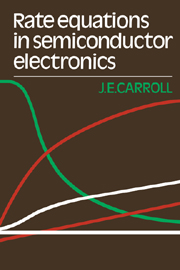Book contents
- Frontmatter
- Contents
- Preface
- 1 Introduction to rate equations
- 2 Elementary rate equations in semiconductors
- 3 Rates of switching
- 4 Rates of change and transfer in phase space
- 5 Rate equations in quantum electronics
- 6 Rate equations in optoelectronic devices
- 7 Advanced topics in rate equations
- Appendix A Counting states
- Appendix B Notes on differences between gas and diode laser rate equations
- Notes on solutions
- References
- Index
6 - Rate equations in optoelectronic devices
Published online by Cambridge University Press: 04 December 2009
- Frontmatter
- Contents
- Preface
- 1 Introduction to rate equations
- 2 Elementary rate equations in semiconductors
- 3 Rates of switching
- 4 Rates of change and transfer in phase space
- 5 Rate equations in quantum electronics
- 6 Rate equations in optoelectronic devices
- 7 Advanced topics in rate equations
- Appendix A Counting states
- Appendix B Notes on differences between gas and diode laser rate equations
- Notes on solutions
- References
- Index
Summary
Models for optoelectronic devices
Introduction
The work here concentrates on semiconductor devices, leaving gas and atomic lasers for further reading. This chapter considers tutorial models for the diode injection laser, the semiconductor light emitting diode (LED) and photodiode (PD), all of which can be understood from the same forms of rate equations, though with different constraints and interpretation. It will be helpful to have models for these three devices before starting on their rate equations.
The light emitting diode
The LED is a p-n junction driven by a current I into forward bias. Electrons and holes recombine close to the junction between the p- and n-materials and give out radiation with a frequency determined by the photon energy which in turn is determined by the material's impurities or band gap. Some fraction of the forward current I is then turned into useful light L (power) formed from photons with a mean energy hfm. The quantum efficiency is η = (eL/hfmI). The more efficient LEDs have a well-defined recombination region (volume Φ). For example, in GaAs LEDs (Fig. 6.1), the region Φ can be defined through the use of ‘heterojunctions’, where a p-type GaAs layer is sandwiched between n- and p-type Ga1−xAlx As materials which have a wider energy gap between conduction and valence band than GaAs materials. On forward bias, holes are driven from the p-Ga1−xAlxAs material into the GaAs, but the potential difference that arises between the valence band of p-type GaAs and n-Ga1−xAlxAs prevents the holes diffusing into the n-Ga1−xAlxAs material.
- Type
- Chapter
- Information
- Rate Equations in Semiconductor Electronics , pp. 104 - 127Publisher: Cambridge University PressPrint publication year: 1986

